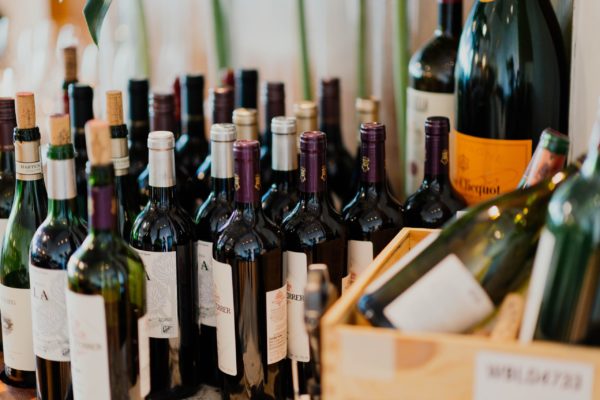When planning a night out or a night in with friends and some wine, you want to have some idea of how much alcohol is in each glass you’re having. You might think that all wine has the same alcohol content, but this isn’t true.
Different wines have different sugar contents, different amounts of calories, different carb counts, and of course, different levels of alcohol by volume or ABV. In this article, we’ll break down the average range of ABVs in wine and let you know how much alcohol is in all the most popular types of wine.
What is the average ABV for wine?
Alcohol by volume, or ABV, is the global standard measurement for alcohol content in any type of beer, wine, or spirit. You’ll usually see the ABV displayed prominently on your wine’s label. The ABV range of your wine will depend on if it’s a fortified wine or not.
Fortified wines, legally speaking, are any wine that has more than 16% ABV but no more than 24% ABV. Unfortified wines are any wine that is 16% or less BV. However, this doesn’t mean that any wine higher than 16% ABV is fortified. Unfortified wines can have higher alcohol concentrations. This is often the case with sweet dessert wines that are achieved by adding sugar and yeast.
The true definition of a fortified wine means the final wine is achieved by adding a spirit to the wine, usually brandy or cognac made from the same type of wine. This method was discovered in the 17th century by wine merchants transporting wine from continental Europe to England. They ran into trouble when the wine spoiled, but they noticed that wine with higher alcohol content was more easily preserved. Some of the most popular fortified wines include Sherry, Port, Madeira, Vermouth, and Marsala.
Now that we understand the difference between fortified wine and unfortified wine, we can break down the average alcohol content. Fortified wines usually range from 15.5% to 25% ABV, with an average ABV of 18%. Unfortified wines range from 5.5% to 16% ABV, with an average ABV of 11.6%.
To put it plainly, a standard five oz. glass of 16% ABV wine contains more than twice as much alcohol as a 5 oz. glass of 7% ABV wine. Be sure to read labels carefully, or you might end up getting a lot tipsier than you planned.
How does alcohol content affect the flavor of wine?
Not only does the ABV of your wine affect how your body reacts to it, but it also affects the flavor of the wine. Firstly, it will have an effect on the flavor harmony of your wine. A wine’s flavor structure is comprised of the relationship between alcohol, acid, sugar, and tannin. These things must always be in balance with each other for a pleasant flavor profile, and all should have similar intensity. If the alcohol content goes up, the others must be raised to keep the wine harmonious and balanced.
The ABV will also affect your wine’s body. Wines can range from light to medium to full-bodied. Since alcohol is more viscous than water, a wine with a higher alcohol content will have a fuller, richer body, while a wine with a lower ABV will taste lighter and more delicate.
The alcohol content in wine can also affect how the wine tastes to an individual. Did you know that your genes can actually dictate how alcohol itself tastes? The higher alcohol content in wine can amplify the sensory experience of bitterness or sweetness in a wine, depending on your genes. Alcohol tastes neutral to about half the world’s population, while a quarter perceives it as bitter, and the remaining quarter perceives it as sweet.
Which has more alcohol: red vs. white?
Overall, red wines tend to have a higher alcohol content than white wines. This comes down to the differences in how they’re made and how their flavor harmony must be balanced. Red wines are fermented with the skin and seeds of the grape and are usually made from darker-colored grapes. White wines are made only from the uncolored pulp and juice of the grape.
The main difference between red wine and white wine is that red wine has tannins, and white wine does not. This is due to the inclusion of the skin and seeds in the red wine-making process. Tannins are a bitter flavor compound found in grape skins. And thus, winemakers must balance the tannins with acidity, sugar, and alcohol to create a pleasant flavor profile. High tannin wines typically have higher alcohol content.
Since white wines don’t have tannins, there is no need to add more alcohol to balance them out. Acidity plays much more of a role in the balancing of their flavor harmony. White wines with high acidity and low alcohol usually taste refreshing and enjoyable, while wines with low acidity and high alcohol are unpleasant. Wines usually don’t have both high acidity and high alcohol. Naturally, white wines will usually have a lower alcohol content, so their flavors are balanced.
How much alcohol is in every type of wine?
Now, we’ll break down where popular wines fall on the alcohol content spectrum. We’ll place them into four categories: very low, moderately low, moderately high, and very high.
Very low alcohol wines
For this category, we’re focusing on wines that are lower than 12.5% ABV. This category includes sparkling wines like Italian Asti and Italian Prosecco and whites like French Vouvray and Muscadet, German Riesling, Portuguese Vinho Verde, and Spanish Txacolina. There are a few rosés in this category as well, like California White Zinfandel and Portuguese rosés. There aren’t any reds in this category because the high tannin content requires more alcohol for balance.
Popular low alcohol bottles include:
- La Marca Prosecco: 11% ABV
- Sutter Home White Zinfandel: 9.5% ABV
- Chateau Ste Michelle Riesling: 12% ABV
Moderately low alcohol wines
This category includes wines that are anywhere from 12.5% ABV to 13.5% ABV. Wines that usually fall into this category are sparkling wines like California, French Champagne, and Spanish Cava. You’ll also find whites such as Austrian Grüner Veltliner, Australian Riesling, French Alsace white, French Loire and Bordeaux whites, French white Burgundy, Italian Pinot Grigio, New York Riesling, New Zealand Sauvignon Blanc, Oregon Pinot Gris, South African Sauvignon Blanc, and Spanish Albarino.
This category also has some rosés, like French rosés, Spanish rosés, and some reds, like French Beaujolais and Burgundy, French Bordeaux, Italian Chianti, and Spanish Rioja.
Popular moderately low alcohol bottles include:
- Dom Pérignon Brut Champagne: 12.5% ABV
- Maso Canali Pinot Grigio: 12.5% ABV
- Listel Grain De Gris Rosé: 12.5% ABV
Moderately high alcohol wines
This category includes wines that are anywhere from 13.5% to 14.5% ABV. There are no sparkling wines in this category, as sparkling wines by nature tend to have less alcohol. There are, however, many more reds in this category, like Argentine Malbec, Australian Shiraz, California Cabernet Sauvignon, California Pinot Noir, California Syrah, Chilean Merlot, French Rhône red, and Italian Barolo. This category includes whites like Australian Chardonnay, California Chardonnay, California Pinot Gris, California Sauvignon Blanc, California Viognier, Chilean Chardonnay, French Sauternes, and South African Chenin Blanc.
Popular moderately high alcohol bottles include:
- La Crema Sonoma Coast Chardonnay: 13.5% ABV
- Yellow Tail Shiraz: 13.5% ABV
- Joel Gott Cabernet Sauvignon: 13.9% ABV
Very high alcohol wines
This category includes wines that are higher than 14.5% ABV. Most of this category includes fortified wines, whites like French Muscat de Beaumes-de-Venise, Portuguese Madeira, and Spanish sherry. There are also some fortified reds, such as Portuguese port. Unfortified reds in this category include California Petite Sirah, California Zinfandel, and Italian Amarone.
- Cockburn Porto Special Reserve Port: 20% ABV
- Carnivor Zinfandel: 14.5% ABV
- Sandeman Porto Tawny 10 Year Port: 20% ABV
The takeaway
You may have heard that the average five-ounce glass of wine has about 12% ABV. While this statistic may tell you the average, there is a huge range of wines on either side of that number. It’s important to recognize which wines have what alcohol content so you can calculate how many glasses you’re able to drink. Three glasses of a California Zinfandel will have a much different effect on your body than three glasses of Italian Prosecco.
There are a few key things to remember when thinking about the alcohol content of different wines. Sparkling wines, white wines, and rosés tend to have a lower alcohol content, while reds and fortified wines tend to be higher. Wines with more tannins tend to have more alcohol. However, these aren’t hard and fast rules, so always check the bottle before drinking.
For all your wine delivery needs, you can count on Saucey. We offer speedy delivery of hundreds of different bottles and absolutely no order minimums. Browse our extensive selection and treat yourself to a bottle today.




